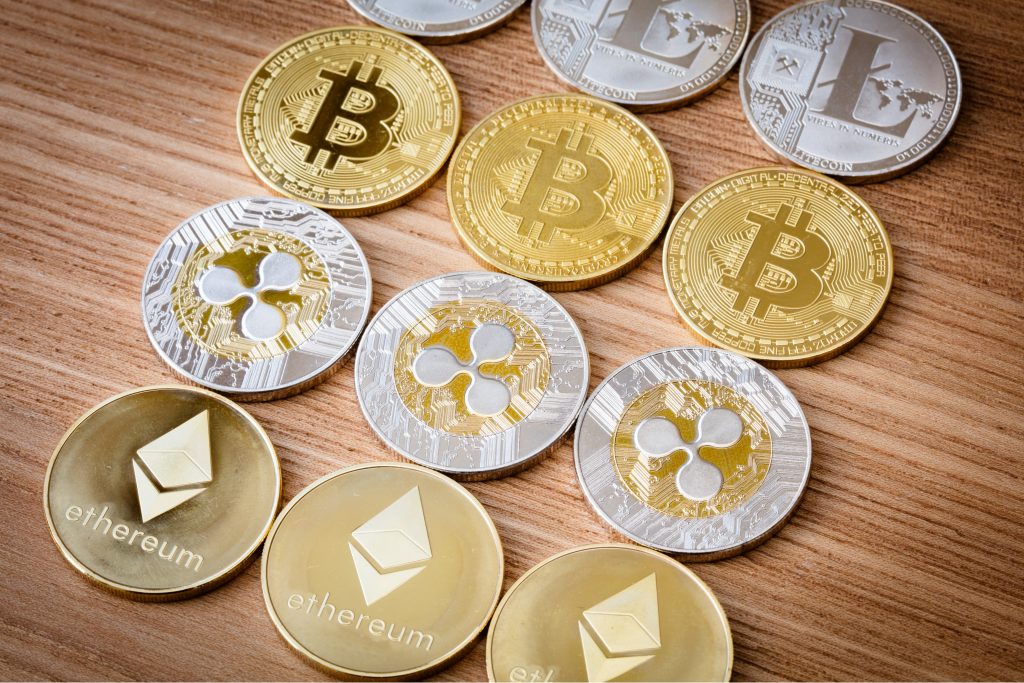A Deep Dive Into The Price Movements Of Popular Tokens
Explore the volatile world of cryptocurrencies and the factors driving the dramatic price movements of popular tokens.

Cryptocurrencies have gained immense popularity in recent years, with many investors looking to capitalize on their price movements. However, not all tokens have experienced a smooth ride. Have you ever wondered what factors contribute to the rise and fall of these popular tokens?
The world of cryptocurrency is a volatile and unpredictable one. While some tokens have skyrocketed in value, others have experienced dramatic declines, leaving investors puzzled and uncertain. Understanding the reasons behind these price movements is crucial for anyone looking to navigate the cryptocurrency market.
In this article, we will delve deep into the price movements of popular tokens, exploring the factors that have influenced their rise and fall. By gaining insight into these dynamics, investors can make more informed decisions and potentially mitigate risks associated with cryptocurrency investments. So, let’s embark on a journey to uncover the mysteries of token price movements.
Overview of the Crypto Market
The crypto market has seen rapid growth and evolution in recent years, becoming a widely discussed and increasingly important element of the global financial landscape. This overview will provide a snapshot of the current state of the crypto market, including key trends, major players, and the overall trajectory of this dynamic and complex sector. With the rise of cryptocurrencies such as Bitcoin and Ethereum, as well as the emergence of various blockchain-based technologies, the market has become a hotbed of innovation and investment. Understanding the broader context and trends within the crypto market is essential for both seasoned investors and those looking to enter this dynamic and often volatile space. This overview will offer valuable insights into the opportunities and challenges within the crypto market, shedding light on its potential impact on the future of finance and technology.

Understanding Token Price Movements
Studying tokens’ price history can provide traders with valuable insight into the patterns of market prices movement and algorithmic indicators. By analyzing historical data, traders can identify trends and make informed decisions about when to buy or sell tokens, leading to consistent average gains. Understanding token price movements is crucial for making informed trading decisions, as it allows traders to assess the potential risks and rewards of their investments. This knowledge helps traders stay ahead of market trends and make strategic moves to maximize profits.
Factors that contribute to the total market cap of cryptocurrency, such as demand, supply, investor sentiment, and technological developments, have a significant influence on token price movements. Understanding these factors can help traders anticipate market movements and adjust their strategies accordingly. By keeping a close eye on the total market cap, traders can gain valuable insights into the broader cryptocurrency market and make more informed decisions about their investments. Overall, studying token price history and understanding the factors that contribute to the total market cap are essential for achieving consistent average gains in the cryptocurrency market.
Popular Cryptocurrencies
Cryptocurrencies have taken the world by storm, with widespread interest in digital currencies that operate independently of a central authority.
Bitcoin (BTC)
Bitcoin (BTC) is currently experiencing a period of volatility, with its price fluctuating between $30,000 and $40,000 in recent weeks. This has been attributed to regulatory concerns, particularly China’s crackdown on cryptocurrency mining, which has led to a significant drop in Bitcoin’s hash rate. Additionally, rumors of potential regulations in various countries have added to the uncertainty surrounding Bitcoin’s future.
The impact of these regulatory concerns and rumors on Bitcoin’s price has been significant, with sharp declines in value followed by brief rallies. Investors are closely monitoring the situation, with some anticipating further price corrections, while others remain optimistic about potential future rallies.
The recent government actions, particularly in China, have raised questions about the long-term viability of Bitcoin and its resilience to regulatory crackdowns. However, many experts believe that despite the short-term challenges, Bitcoin’s price will eventually stabilize and potentially rally as regulatory clarity increases and investor confidence returns.
Ethereum (ETH)
Ethereum (ETH) was conceptualized by programmer Vitalik Buterin in 2013, and the development was crowdfunded through an Initial Coin Offering (ICO) in 2014. The platform officially launched in 2015, aiming to expand blockchain technology beyond just cryptocurrency transactions.
Ethereum has experienced notable price surges, notably reaching an all-time high in 2018 before crashing along with the broader cryptocurrency market. The founding team includes Vitalik Buterin, Joseph Lubin, Gavin Wood, and other key figures in the blockchain space.
In its transition to a proof-of-stake mechanism, Ethereum is moving away from the energy-intensive proof-of-work model to increase scalability and reduce environmental impact.
The use case and adoption of Ethereum have expanded beyond just a cryptocurrency, with its smart contract functionality being utilized in various industries including finance, supply chain, and gaming. Ethereum’s tokenomics are centered around the native cryptocurrency Ether (ETH), used for transactions and fueling the network.
Ethereum has a strong community with widespread support from developers and users, contributing to its continued growth and impact in the blockchain space.
Ripple (XRP)
As of the current status, Ripple (XRP) has seen mixed performance since the crypto bubble of 2017-2018. The price of XRP reached an all-time high during that period, but it has since experienced fluctuations in value.
One significant development for Ripple is the ongoing legal battle with the U.S. Securities and Exchange Commission (SEC), which has impacted the price and market trends of XRP. The lawsuit alleges that Ripple violated U.S. securities laws by selling XRP as an unregistered security. This has led to heightened uncertainty and volatility in the XRP market.
Additionally, Ripple has continued to make partnerships and developments in the fintech industry, including collaborations with major financial institutions and the launch of new products and services. Despite these efforts, the legal challenges have overshadowed some of the positive developments for XRP.
Overall, the performance of Ripple (XRP) has been impacted by both legal and market factors, leading to a fluctuating price and uncertain market trends.
Litecoin (LTC)
Litecoin (LTC) is a peer-to-peer cryptocurrency that was created by Charlie Lee, a former employee of Google. One of its key features and characteristics is its use of the Scrypt algorithm, which sets it apart from Bitcoin’s SHA-256 algorithm. This algorithm allows for faster block generation times, making transactions on the Litecoin network quicker compared to Bitcoin.
Additionally, Litecoin has a significant market capitalization, making it one of the top cryptocurrencies in the market. It is widely accepted by various merchants for transactions, allowing users to make purchases with Litecoin in a wide range of goods and services.
Cardano (ADA)
Cardano (ADA) is a next-generation blockchain platform known for its key features and benefits, including its advanced smart contract and dApp capabilities. Its approach to addressing scalability, interoperability, and sustainability sets it apart in the crypto space. Cardano’s blockchain technology incorporates a layered architecture that enables flexibility and adaptability, making it an ideal platform for developers to build and deploy decentralized applications. This, coupled with its focus on sustainability and energy efficiency, makes Cardano a promising option for the future of blockchain.
The project’s success is bolstered by its strong tokenomics, experienced development team, and supportive community. The transparent and secure platform, along with its high performance, further contributes to Cardano’s appeal. With its emphasis on research and peer-reviewed work, Cardano ensures the highest level of security and reliability for its users. Overall, Cardano’s dedication to innovation, scalability, and sustainability, combined with its robust development team and community support, positions it as a leading player in the blockchain industry.
Binance Coin (BNB)
Binance Coin (BNB) is currently facing significant challenges due to the recent SEC charges and regulatory pressure. The SEC’s lawsuit against Binance, the parent company of Binance Coin, has created uncertainty and raised concerns about the future of the cryptocurrency. This has led to a decrease in investor sentiment and market dynamics for BNB.
One of the main issues facing BNB is its centralized foundation, which makes it vulnerable to regulatory influence and potential fraudulent behavior. The centralization of BNB raises questions about its trust and reliability, as well as its susceptibility to external pressures and control.
As a result of these developments, investors may have to reconsider their trust and investment decisions in BNB. The regulatory scrutiny and potential impact on the market dynamics and investor sentiment are likely to have a significant influence on the future of Binance Coin.
Polkadot (DOT)
Polkadot (DOT) is currently one of the top cryptocurrencies with a market capitalization of over $30 billion. Its trading volume and liquidity have been steadily increasing, indicating strong investor interest. The platform aims to enable interoperability between different blockchain networks, fostering seamless communication and data sharing. This could potentially lead to widely adopted use cases in various industries, indicating strong adoption potential.
Polkadot’s tokenomics are designed to incentivize participation and security on the network. The development team comprises of experienced professionals with a strong track record in the blockchain space, while the community support for Polkadot is also growing steadily. This is indicative of its potential for wider adoption.
In terms of security and transparency, Polkadot employs a robust protocol and has been subject to rigorous audits. Overall, Polkadot is positioned as a promising platform for the future of decentralized applications and the broader blockchain ecosystem.
Uniswap (UNI)
Uniswap (UNI) is a digital asset that is part of the Uniswap decentralized exchange protocol, which operates on the Ethereum blockchain. Launched in 2018, Uniswap has been a pioneer in offering decentralized and automated cryptocurrency token trading, allowing users to swap various digital assets without the need for a traditional intermediary.
UNI serves as the governance token for the Uniswap platform, providing holders with the ability to participate in decision-making processes about the protocol’s future developments and upgrades. This gives UNI holders a say in the direction and evolution of Uniswap, making it a crucial element in the platform’s decentralized governance model.
Uniswap’s innovative approach to decentralized exchange and its use of the Ethereum network has made it a significant player in the cryptocurrency space. With its governance token UNI serving as a key to decision-making, Uniswap has demonstrated a commitment to community involvement in shaping the future of decentralized finance.
Chainlink (LINK)
Chainlink (LINK) is a cryptocurrency that serves as a decentralized oracle network, allowing smart contracts on blockchain platforms to securely connect with external data sources. The purpose of Chainlink is to ensure the accuracy and reliability of data that smart contracts rely on, as the network acts as a bridge between on-chain and off-chain systems.
Chainlink achieves this by utilizing a network of nodes that work to retrieve and verify external data before delivering it to the smart contracts. This decentralized approach to sourcing and validating data helps to mitigate the risk of tampering or inaccuracies, thus making Chainlink a crucial component in the decentralized finance (DeFi) ecosystem.
As the DeFi space continues to grow, the need for reliable and secure data inputs for smart contracts becomes increasingly important, and Chainlink plays a vital role in fulfilling this need. Its ability to provide trustworthy data to the DeFi ecosystem makes it a valuable and sought-after cryptocurrency in the blockchain industry.

Conclusion
In conclusion, the price movements of popular tokens offer a fascinating case study into the dynamics of digital asset trading. While the most popular tokens have seen tremendous growth over the past few years, it is important to remember that prices are never guaranteed and can shift drastically in a short amount of time. By understanding the factors that drive token prices, investors can better prepare themselves for potential fluctuations and make more informed investment decisions.





